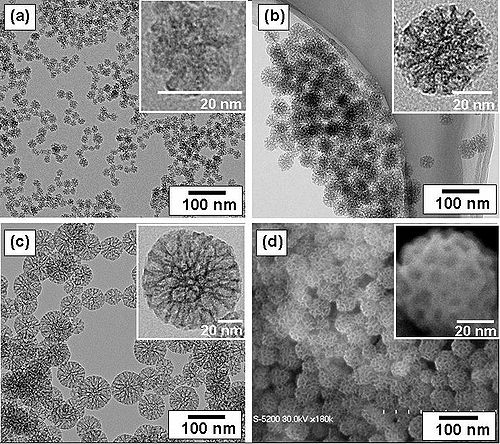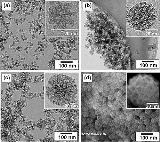
Mesoporous silica
Encyclopedia
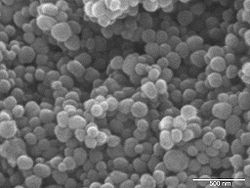 |
| General information |
|---|
| Name: Mesoporous silica |
| Appearance: fine white powder |
| Types: MCM-41, SBA-15, MSU-, KSW-, FSM-, HMM- |
| Main component: amorphous silica |
Mesoporous silica is a form of silica and a recent development in nanotechnology
Nanotechnology
Nanotechnology is the study of manipulating matter on an atomic and molecular scale. Generally, nanotechnology deals with developing materials, devices, or other structures possessing at least one dimension sized from 1 to 100 nanometres...
. The most common types of mesoporous nanoparticles are MCM-41 and SBA-15. Research continues on the particles, which have applications in catalysis
Catalysis
Catalysis is the change in rate of a chemical reaction due to the participation of a substance called a catalyst. Unlike other reagents that participate in the chemical reaction, a catalyst is not consumed by the reaction itself. A catalyst may participate in multiple chemical transformations....
, drug delivery
Drug delivery
Drug delivery is the method or process of administering a pharmaceutical compound to achieve a therapeutic effect in humans or animals. Drug delivery technologies modify drug release profile, absorption, distribution and elimination for the benefit of improving product efficacy and safety, as well...
and imaging
Medical imaging
Medical imaging is the technique and process used to create images of the human body for clinical purposes or medical science...
.
History
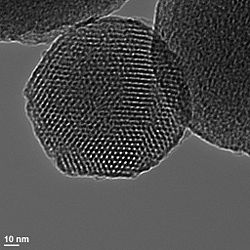
Six years later, silica nanoparticles with much larger 4.6 to 30 nanometer pores were produced at the University of California, Santa Barbara
University of California, Santa Barbara
The University of California, Santa Barbara, commonly known as UCSB or UC Santa Barbara, is a public research university and one of the 10 general campuses of the University of California system. The main campus is located on a site in Goleta, California, from Santa Barbara and northwest of Los...
. The material was named Santa Barbara Amorphous type material, or SBA-15. These particles also have a hexagonal array of pores.
The researches who invented these types of particles planned to use them as molecular sieves. Today, mesoporous silica nanoparticles have many applications in medicine
Medicine
Medicine is the science and art of healing. It encompasses a variety of health care practices evolved to maintain and restore health by the prevention and treatment of illness....
, biosensor
Biosensor
A biosensor is an analytical device for the detection of an analyte that combines a biological component with a physicochemical detector component.It consists of 3 parts:* the sensitive biological element A biosensor is an analytical device for the detection of an analyte that combines a biological...
s, and imaging.
Synthesis
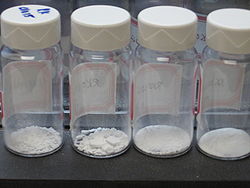
Tetraethyl orthosilicate
Tetraethyl orthosilicate is the chemical compound with the formula Si4. Often abbreviated TEOS, this molecule consists of four ethyl groups attached to SiO44- ion, which is called orthosilicate. As an ion in solution, orthosilicate does not exist. Alternatively TEOS can be considered to be the...
with a template made of micellar rods. The result is a collection of nano-sized spheres or rods that are filled with a regular arrangement of pores. The template can then be removed by washing with a solvent adjusted to the proper pH
PH
In chemistry, pH is a measure of the acidity or basicity of an aqueous solution. Pure water is said to be neutral, with a pH close to 7.0 at . Solutions with a pH less than 7 are said to be acidic and solutions with a pH greater than 7 are basic or alkaline...
.
In another technique, the mesoporous particle could be synthesized using a simple sol-gel method or a spray drying method. Tetraethyl orthosilicate is also used with an additional polymer monomer (as a template).
Drug delivery
The large surface area of the pores allows the particles to be filled with a drug or a cytotoxin. Like a Trojan HorseTrojan Horse
The Trojan Horse is a tale from the Trojan War about the stratagem that allowed the Greeks finally to enter the city of Troy and end the conflict. In the canonical version, after a fruitless 10-year siege, the Greeks constructed a huge wooden horse, and hid a select force of men inside...
, the particles will be taken up by certain biological cells though endocytosis
Endocytosis
Endocytosis is a process by which cells absorb molecules by engulfing them. It is used by all cells of the body because most substances important to them are large polar molecules that cannot pass through the hydrophobic plasma or cell membrane...
, depending on what chemicals are attached to the outside of the spheres. Some types of cancer cells will take up more of the particles than healthy cells will, giving researchers hope that MCM-41 will one day be used to treat certain types of cancer.
Ordered mesoporous silica (e.g. SBA-15, TUD-1, HMM-33, and FSM-16) also show potential to boost the in vitro and in vivo dissolution of poorly water soluble drugs. Many drug-candidates coming from drug discovery suffer from a poor water solubility. An insufficient dissolution of these hydrophobic drugs in the gastrointestinal fluids strongly limits the oral bioavailability. One example is itraconazole
Itraconazole
Itraconazole , invented in 1984, is a triazole antifungal agent that is prescribed to patients with fungal infections. The drug may be given orally or intravenously.-Medical uses:...
which is an antimycoticum known for its poor aqueous solubility. Upon introduction of itraconazole-on-SBA-15 formulation in simulated gastrointestinal fluids, a supersaturated solution is obtained giving rise to enhanced transepithelial intestinal transport. Also the efficient uptake into the systemic circulation of SBA-15 formulated itraconazole has been demonstrated in vivo (rabbits and dogs). This approach based on SBA-15 yields stable formulations and can be used for a wide variety of poorly water soluble compounds.
Biosensors
The structure of these particles allows them to be filled with a fluorescent dye that would normally be unable to pass through cell walls. The MSN material is then capped off with a molecule that is compatible with the target cells. When the MSNs are added to a cell culture, they carry the dye across the cell membrane. These particles are optically transparent, so the dye can be seen through the silica walls. The dye in the particles does not have the same problem with self-quenching that a dye in solution has. The types of molecules that are grafted to the outside of the MSNs will control what kinds of biomolecules are allowed inside the particles to interact with the dye.Gallery
